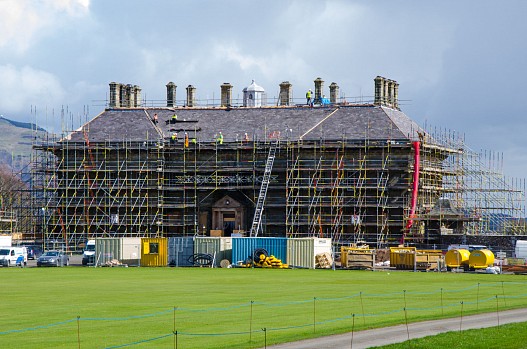
Kinross House is the first, and most important, neoclassical Palladian mansion built in Scotland. Described in Country Life Magazine as ‘the complete expression in stone of the Renaissance in Scotland’ the property was Sir William Bruce’s greatest masterpiece.
Located between Loch Leven Castle and the town of Kinross, the Estate possesses one of the most historic views in Scotland, directly across from the 11th-century castle where Mary Queen of Scots was imprisoned and finally abdicated.


Around this time, construction is believed to have begun on Loch Leven Castle. Today it is one the most important medieval castles in Scotland and is one of the jewels of the Kinross House Estate.

During the first war of Scottish Independence (1296 – 1328) the invading English army held the castle, but before the end of the century, it was later recaptured by Scottish forces led by Sir William Wallace, who was immortalised in the film Braveheart. Lochleven Castle became one of only five castles to hold out against the English (during David II’s reign) at the time.

Robert the Bruce moved part of the royal exchequer to Loch Leven. Bruce stayed here in 1313 and 1323 and was the first to use the castle as a prison. Evidently, he had confidence in its security potential.

Robert Stewart, later to become King Robert II, the first of the Royal House of Stewart, was imprisoned by King David II in the castle for a spell in 1369, as the complicated politics of the age unfolded. King Robert II later granted the castle to Sir Henry Douglas and the Douglases held the castle up to the 17th century.

Lochleven Castle and estate lands were conveyed by Robert II to the Douglas family, in whose possession it remained for the next 300 years.

As a guest of the owner, Sir William Douglas, it was at the castle she debated the Scottish Reformation with John Knox.

She later returned to the castle as a prisoner between 1567 and 1568 and was forced to abdicate the throne in favour of her infant son, James VI during her captivity. Dramatically, she escaped across the loch and went into exile in England, never to return to Scotland again.

The castle remained in the ownership of the Douglas family, Earls of Morton until it was purchased by Sir William Bruce who used the castle as the easternmost focal part of his famous designed landscape to create Kinross House.
Sir William Bruce landscaped the grounds and planted the formal gardens ten years prior to the construction of Kinross House so it would be set in a mature landscape.

The estate was purchased by George Graham in 1777 and passed through marriage to the Montgomery family.

Mr. Fothergill’s purchase heralded the beginning of a total renovation project of a magnitude that can only be described as a labour of love. Teams of specialists were carefully picked to return this magnificent building to its former glory whilst also providing it with state of the art capability.

The restoration work was completed in 2013 and the property was winner of the prestigious Historic Houses Association and Sotheby’s UK Restoration Award of the Year. No expense has been spared to make this breathtaking property reflect Sir William Bruce’s vision for opulent entertaining which will only be seen and experienced by the few.

Kinross House now welcomes guests to hire the estate on a strictly exclusive use basis for private celebrations, family gatherings and the ultimate luxury, once-in-a-lifetime stay.

The Estate offers exclusive hire of Kinross House and The Coach House.
Contact Us